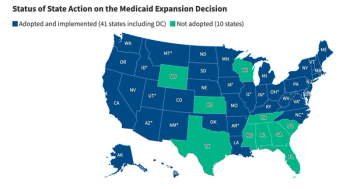
KRAS Mutation Could Guide Treatment Decisions in Nonsmall Cell Lung Cancer
Chemo in combination with immunotherapy was preferable to immunotherapy alone in patients with a mutation of the KRAS gene and high levels of programmed cell death ligand 1, according to findings reported in JAMA Oncology.
Cancer treatment tailored to genetic markers is fast becoming a reality, and researchers are beginning to tease out which treatments to use with particular mutations, adding even more precision to precision medicine guided by biomarkers. But according to new research, patients with nonsmall cell lung cancer (NSCLC) who have high levels of programmed cell death ligand 1 (PD-L1) and have a mutation in the KRAS gene have similar outcomes when treated with either immune checkpoint inhibition monotherapy or chemoimmunotherapy.
The same is not true, though, for patients lacking the KRAS mutation, according results published recently in
The results, based on data from more than 1,100 patients, show that those without the KRAS mutation have better outcomes when treated with the combination of chemotherapy and immunotherapy versus immunotherapy alone.
The findings may have important treatment implications for 1 in 6 patients with nonsquamous NSCLC.
Patients with NSCLC and PD-L1 expression greater than 50% typically receive a first-line therapy of either immune checkpoint inhibition monotherapy or in combination with chemotherapy.
Recent developments, however, have created opportunities to significantly improve the care of NSCLC and further refine treatment choices.
Other research has suggested that the presence or absence of mutations in the KRAS gene might have implications for the success of a particular therapy. However, the question of whether the genetic variation affects treatment outcomes in patients with high levels of PD-L1 had not yet been studied.
Sun and her colleagues used the database assembled by Flatiron Health, a healthcare technology company that focuses on cancer, to conduct their study. The Flatiron database includes data from 280 cancer centers in the United States. The researchers sifted through the data to identify patients with advanced nonsquamous NSCLC with PD-L1 expression of at least 50%, known KRAS status, and no alterations in EGFR, ALK, or ROS1 genes. They found 1,127 patients who fit those criteria and who were treated with either first-line immune checkpoint inhibition alone monotherapy or "chemoimmunotherapy" — chemotherapy and immunotherapy.
When they categorized the high PD-L1 patients by their KRAS status, they found that they were split evenly between those with KRAS mutations and those with so-called wild-type KRAS (50.8% versus 49.2%).
Among patients with KRAS mutations, the median overall survival (OS) among those treated with immune checkpoint therapy alone and those treated with chemoimmunotherapy was basically the same (21.1 months compared 20.0 months).
“Patients with KRAS mutation and high PD-L1 expression had excellent survival when treated with immunotherapy either alone as well as after receipt of combination chemo-immunotherapy,” Sun told Managed Healthcare Executive®.
But among patients with unmutated “wild type” KRAS (KRASwt), chemoimmunotherapy offered an advantage. The median OS in those patients was 19.3 months; it was 13.6 months in those treated with immune checkpoint therapy alone. The difference must be interpreted with some caution because it wasn’t, statistically speaking, significant.
“These data suggest that chemoimmunotherapy might be favored over (immune checkpoint inhibition) for patients with KRASwt with high PD-L1 expression,” Sun and her co-investigators wrote.
Sun said the new analysis offers an important piece of molecular data that can help guide clinicians and patients in their decision-making processes.
The insights could affect about 1 in 6 patients with nonsquamous NSCLC because one-third of patients with NSCLC have high levels of PD-L1, and about half of patients with high levels of PD-L1 have a KRAS mutation, said Sun and her colleagues.
Newsletter
Get the latest industry news, event updates, and more from Managed healthcare Executive.






















































